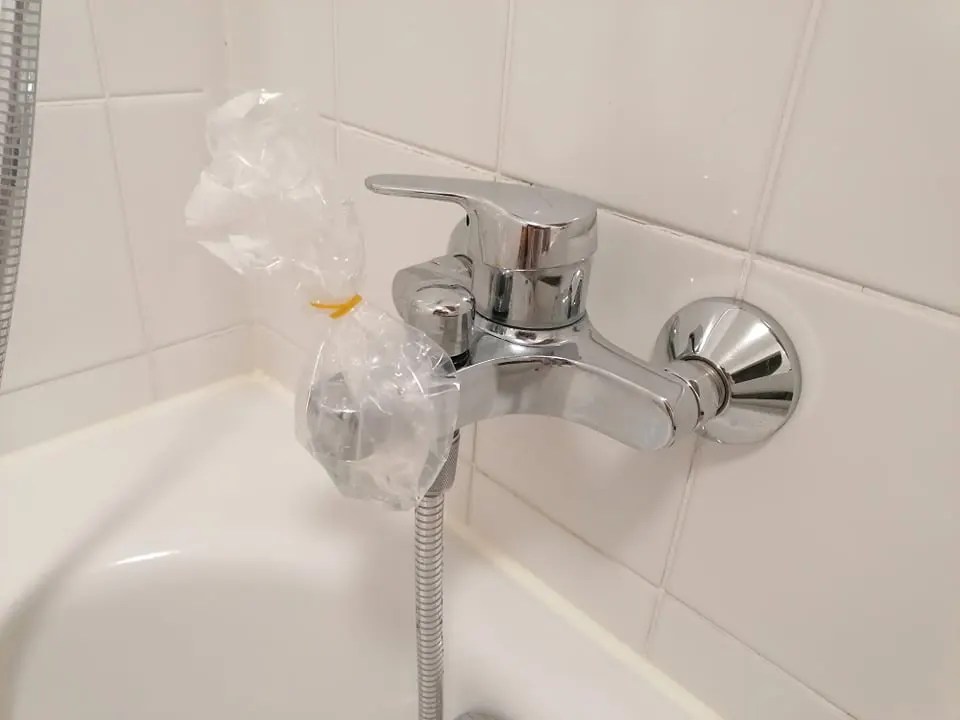Whether on the sink or in the kettle – limescale deposits occur mainly in the kitchen and bathroom. The white stains not only look unattractive, they are also extremely stubborn. What really helps against limescale and can it be removed with household remedies?
Removing limescale with household remedies
Two well-known household remedies have proven effective in getting rid of stubborn deposits: Vinegar and citric acid. The acid dissolves the limescale and it can then be easily wiped off. However, both household remedies have their advantages and disadvantages, which is why you should bear a few things in mind when using them.
1. remove limescale with vinegar
- The best way to remove limescale is to use household vinegar (5 percent acetic acid) or dilute vinegar essence (25 percent acetic acid) in a ratio of 1:5 with water.
- Place calcified shower heads, faucet aerators and sink faucets in a cup or bowl filled with vinegar. It will take some time until they are clean again and the limescale has dissolved.
- A kitchen towel soaked in vinegar helps with limescale deposits in the sink or at the transition between the sink and tap.
- You can also use vinegar to clean the kettle. Mix 2-3 tablespoons of vinegar essence with at least one liter of water and bring the mixture to the boil in the kettle. The kettle must then be thoroughly rinsed out.
Take care with seals and fittings
The acid contained in vinegar can attack rubber and plastic parts, such as seals. It is therefore better not to clean coffee machines with vinegar. The thin chrome layer on taps and other fittings can also be damaged by the vinegar.
Many people also find the pungent smell of vinegar unpleasant. When vinegar is boiled, it even produces corrosive vapors that should not be inhaled under any circumstances. Therefore, ensure adequate ventilation when working with vinegar and rinse all treated appliances and surfaces with water.
2. remove limescale with citric acid
Natural lemon juice contains between six and eight percent acid. However, pure citric acid (also known as citric acid) is usually used for descaling. You can buy it in powder form or in liquid form at the drugstore. This is how you use it for cleaning:
- Coffee machines: Dissolve two to three tablespoons of citric acid in one liter of water and run the mixture through the machine. Then rinse twice with clear water.
- Kettle: Dissolve two to three tablespoons of citric acid in one liter of water and heat the mixture directly in the kettle.
- Dishwasher: Sprinkle six tablespoons of citric acid into the empty dishwasher, avoiding the sieve. Select a program without a pre-rinse cycle at a minimum of 50 °C and run the machine through.
- Stainless steel, plastic, ceramic or chrome surfaces: Dissolve three tablespoons of citric acid in one liter of water and wipe the calcified surfaces with it.
- Washing machine: Mix six tablespoons of citric acid with half a liter of water and pour the mixture directly into the drum. Start a 60°C program without prewash and without textiles in the drum.
- Teapots, cups and coffee mugs: Depending on the size of the container, add half a tablespoon or a whole tablespoon of citric acid and fill with hot water. Leave to act briefly and then rinse with water.
- Shower heads and fittings: Dissolve one and a half tablespoons of citric acid in a quarter of a liter of water and immerse the calcified parts directly in the solution. A plastic bag can help with non-removable parts.

Although citric acid does not smell like lemon, it does not leave an unpleasant odor, unlike vinegar. It can also be used without hesitation to clean rubber or plastic parts and is very versatile. For particularly stubborn limescale, however, the exposure time is several hours. The same basic rule applies here: After cleaning, rinse with clean water.
Tip: Natural lemon juice (from a squeezed lemon, for example) can also be used for light calcification.
Removing ingrained limescale
Ingrained limescale can be a real challenge, as it often stubbornly clings to corners, fittings or the inside of appliances. To remove this limescale, you should use acidic cleaning agents – vinegar, citric acid or special limescale removers are particularly effective here. First, it is advisable to treat the affected surfaces generously with the cleaning agent and leave it to work for a few minutes so that the acid slowly softens the limescale.
You can then remove the limescale mechanically using a brush or sponge that is not too abrasive. For very stubborn deposits, it often helps to repeat the process or leave the cleaning agent to work overnight. Make sure you rinse thoroughly with water after cleaning to remove any acid residue that could attack the material. This will ensure that your fittings and surfaces are not only free of limescale, but also remain in optimum condition.
Correct procedure for sensitive materials
Before you declare war on limescale deposits in your household, it is best to try out the two household remedies on an inconspicuous area. Materials such as natural stone and marble generally do not tolerate acid and should be treated with other products. Vinegar is also not suitable for cleaning copper and aluminum.
Vinegar and citric acid have proven to be particularly effective in removing limescale. Would you still prefer to experiment or try something new? Then try toothpaste, cola, a paste made from baking powder and water or baking paper.
Attention: Caution is advised when cleaning with acids. In the event that your hands come into contact with the cleaning water, you should wear rubber gloves if possible. Avoid getting acid in your eyes at all costs.

Source: ndr
Preview image: ©Leonsbox via Getty Images
